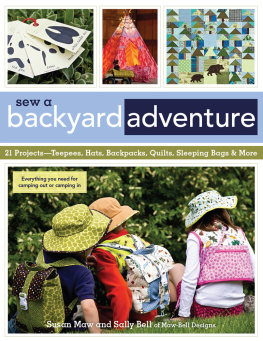Holley - Tipis, Tepees, Teepees: History and Design of the Cloth Tipi
Here you can read online Holley - Tipis, Tepees, Teepees: History and Design of the Cloth Tipi full text of the book (entire story) in english for free. Download pdf and epub, get meaning, cover and reviews about this ebook. year: 2007, publisher: Gibbs Smith, genre: Home and family. Description of the work, (preface) as well as reviews are available. Best literature library LitArk.com created for fans of good reading and offers a wide selection of genres:
Romance novel
Science fiction
Adventure
Detective
Science
History
Home and family
Prose
Art
Politics
Computer
Non-fiction
Religion
Business
Children
Humor
Choose a favorite category and find really read worthwhile books. Enjoy immersion in the world of imagination, feel the emotions of the characters or learn something new for yourself, make an fascinating discovery.
- Book:Tipis, Tepees, Teepees: History and Design of the Cloth Tipi
- Author:
- Publisher:Gibbs Smith
- Genre:
- Year:2007
- Rating:5 / 5
- Favourites:Add to favourites
- Your mark:
- 100
- 1
- 2
- 3
- 4
- 5
Tipis, Tepees, Teepees: History and Design of the Cloth Tipi: summary, description and annotation
We offer to read an annotation, description, summary or preface (depends on what the author of the book "Tipis, Tepees, Teepees: History and Design of the Cloth Tipi" wrote himself). If you haven't found the necessary information about the book — write in the comments, we will try to find it.
Abstract: Tipis, Tepees, Teepees is the history and evolution of the tipi, with instructions on how to make your own
Holley: author's other books
Who wrote Tipis, Tepees, Teepees: History and Design of the Cloth Tipi? Find out the surname, the name of the author of the book and a list of all author's works by series.
Tipis, Tepees, Teepees: History and Design of the Cloth Tipi — read online for free the complete book (whole text) full work
Below is the text of the book, divided by pages. System saving the place of the last page read, allows you to conveniently read the book "Tipis, Tepees, Teepees: History and Design of the Cloth Tipi" online for free, without having to search again every time where you left off. Put a bookmark, and you can go to the page where you finished reading at any time.
Font size:
Interval:
Bookmark:

Tipis | Tepees | Teepees
History and Design of the Cloth Tipi
Digital Edition 1.0
Text 2007 Linda A. Holley
Photographs and drawings 2007 as noted in the photo credits chapter
All rights reserved. No part of this book may be reproduced by any means whatsoever without written permission from the publisher, except brief portions quoted for purpose of review.
Gibbs Smith
P.O. Box 667
Layton, Utah 84041
Orders: 1.800.835.4993
www.gibbs-smith.com
ISBN: 978-1-4236-1140-0
To all my tipi slaves and those who love a night and a day in a tipi.
I wish to thank all the members of Material Culture of the Prairie, Plains, and Plateau and Lodge Owners discussion Web site groups. The input of the following peopleBill Holmes, Benson Lanford, Jan Kristek, Billy Maxwell, Bill and Kathy Brewer, Bob Brewer, Peter Gibbs, Creig White, Georg Barth, Jack in the Black Hills, Ted Asten, Mike Terry, David Sager, David Ansonia, Alexander Barber, Duane Alderman, Carolyn Corey, Mike Cowdrey, Allen Chronister, Ken Weidner, Curtis Carter, and the many others who helped by doing historic research, locating photos, e-mailing, and sending packages of informationhas been invaluable. They made this book possible.
Thanks also to all of those wonderful people who kept my life sane during repeated computer crashes; three hurricanes (Francis, Ivan, and Jean) that left me with no electricity for weeks; surgery to fix my hand that was smashed during Hurricane Jean; and my knee replacement, which all my accidents with tipi poles contributed to. A special thanks to Weird Wayne McDowell who traveled from Illinois to Florida for the making of a 12-foot tipi. He took over five thousand pictures... and I only used about fifteen. Tipi slaves Bill Burns and Mike Ketchum endured a very intense week of filming and cutting and being yelled at by an unforgiving taskmaster. At least they got food and some money out of this and my gratitude. Thanks also to Jay Deen, my first tipi slave, who helped build many of the three hundred tipis that came from Alligator Trading Co., my tipi company.
Thanks to the tipi makers around the world (Richard Reese of Reese Tipis, Nomadics, Strinz Tipis, Spring Valley, R. K. Lodges, Wolf Glen Lodges of England/Scotland, Rainbow Tipis of Australia, Arrow Tipis of Canada, and others), who answered my phone calls and e-mails with a wealth of information in photos and personal tidbits, which they were not afraid to pass on to me. A big acknowledgment to Louis W. Jones and Doug Rodgers who kept me up late at night with questions and the inquisitiveness to go find the answers or the usual when will the book be done? And a special thanks to James E. Dudley and Ed De Torres who took the time to sit down with me and edit hundreds of pages of information into something readable.
My interest in tipis began about 1971 when my husband and I saw a neighbor working on a set of tipi poles and we just had to dive in and help. That was it. Tipi fever hit us and we just had to have one. During the Christmas holidays of 1972, we ordered our first tipi, an 18-footer from Darry Wood. It arrived one night in the back of Darrys truck. I wanted to start painting it right away, but someone wisely advised me to wait a year, do some research, and then decorate. So, we began our research, finally settling on a beaded Cheyenne-style cover with a painted lining. We took that tipi everywhereto rendezvous, powwows, and campouts.
When my husband and I split the blanket in 1977, I kept the tipi and continued to travel to events. In 1978, I accepted the challenge to make a tipi. With David Clayton, I headed down to south Florida to buy an industrial sewing machine. From 1978 to 1995, I sewed over three hundred lodges, sometimes with the assistance of tipi slaves (those foolish enough to volunteer to help me). During all of these years of making tipis, going to various gatherings, doing beadwork, and making tipi accoutrements, I was studyingdoing research and listening to those knowledgeable about tipi life.
Like virtually all tipi lovers of my generation, I learned a lot from the classic work on tipis, The Indian Tipi: Its History, Construction, and Use, by Reginald and Gladys Laubin. This book, published in 1957 and still in print, proved to be a wellspring of knowledge and inspiration; it spread the lore of the tipi literally all over the world. In Europe, however, the tipi was already in use before the publication of the Laubins book. In the early twentieth century, there were already American Indian hobbyists in Europe, especially in Germany, inspired by the works of novelist Karl May and the Wild West show of Buffalo Bill Cody. Even so, it is fair to say that the Laubin book, as it is affectionately called by tipi lovers, stimulated newcomers to the tipi worldwide. Today tipis are made and camped in on every continent but Antarctica (but it might be possible to use them there as well!). The modern tipi lovers debt to the Laubins is enormous.
It is time, however, to reassess. The Laubins wrote about the tipis they knew best, the tipis of the 1940s and 1950s. The tipis of that era represented a particular stage in the evolution of tipi design and construction. The cloth tipis, still popular at the time the Laubins book was written, had replaced the early buffalo-hide tipis. Since then, tipi construction has evolved due to amazing developments in technology. So, focusing on the progress the tipi has undergone, this book will address three areas: first, the history and evolution of the tipi; second, a step-by-step process of acquiring or making your own tipi; and third, current uses of tipis, drawing on the experiences of tipi lovers all over the world.

The nomadic dwelling structure of the American Indian is called several names by many different tribes. The Apsaroka, Apsalooke, or Crow Native Americans call the tipi ash (home) or ashtale (real home). The Blackfoot call it ] In the last 175 years, the tipi has evolved in materials used, construction techniques, and usage. It has gone from buffalo and elk hides to cloth and now to the synthetic materials of the twenty-first century. The two important innovations in tipis were first the use of horses for transporting bigger poles and larger hide lodges. Then in the early nineteenth century came the introduction of cloth covers.
The information about the historic tipi and tipi camp of the early to late nineteenth century in this chapter is taken from historic ledger drawings, daguerreotypes (tin types), glass slides, photographs, and handwritten documentation. Many pieces of information come from diaries, observations of clergy and the military, trappers and rendezvous people, visitors to tribal camps, and trading post lists of materials. Secondhand material, not directly observed or experienced, was avoided in collecting this information. One main exception is the quoted material from the late James H. Creighton that follows in the next section. Since many books written in the mid-1800s were not published until later in the twentieth century, the bibliography in the back of the book lists the sources by the date they were originally written or when the major firsthand information was observed.
Font size:
Interval:
Bookmark:
Similar books «Tipis, Tepees, Teepees: History and Design of the Cloth Tipi»
Look at similar books to Tipis, Tepees, Teepees: History and Design of the Cloth Tipi. We have selected literature similar in name and meaning in the hope of providing readers with more options to find new, interesting, not yet read works.
Discussion, reviews of the book Tipis, Tepees, Teepees: History and Design of the Cloth Tipi and just readers' own opinions. Leave your comments, write what you think about the work, its meaning or the main characters. Specify what exactly you liked and what you didn't like, and why you think so.











